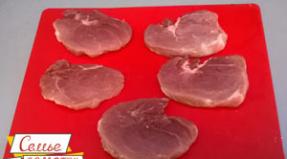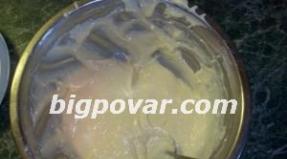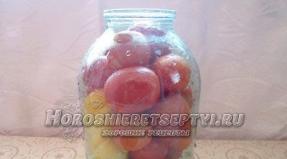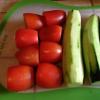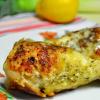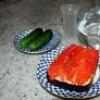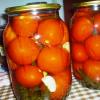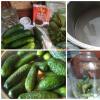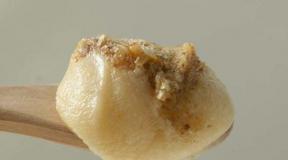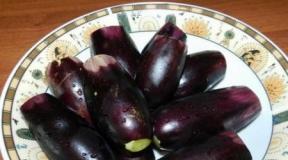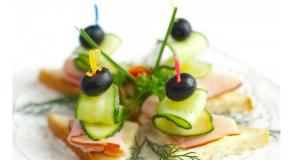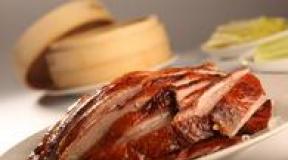What should be a persimmon soft or hard. The best varieties of persimmon
In the cold season, many people want to pamper themselves with something tasty and at the same time beneficial to their health. In this case, such a wonderful fruit like persimmon is perfect. After all, sweet ripe persimmon is not only very tasty, but also has a mass of beneficial substances for the body, vitamins and minerals.
It is rich in calcium and iron, therefore it increases blood hemoglobin, prevents anemia and anemia.
Beta-carotene, contained in persimmon, strengthens the eyes, slows down the aging process, reduces the likelihood of cancer. Therefore, persimmon is recommended to use for people who smoke.
Persimmon also contains iodine, so its use reduces the risk of inflammation of the thyroid gland.
In addition, this wonderful fruit has a diuretic effect and serves as a prevention of urolithiasis.
Persimmon is very nutritious because it contains a large amount of glucose and sucrose. Therefore, this fruit should be used with caution in people with diabetes.
There are several hundred varieties of persimmon, differing in their shape, color and size. But in most cases, if the fruits are not quite ripe, they will have a not very pleasant tart and astringent flavor. Therefore, if you want to enjoy sweet, tasty and impatient persimmon, first of all, you need to choose only fully ripe fruits, the flesh of which has a jelly-like consistency.
The only exception is such a form of persimmon, as the "Kinglet". The fruits of this variety are dark orange on the outside and brownish on the inside. Such persimmon has a delicate sweet taste, even if the fruit is not quite ripe. But in the case of the “king” there is one nuance. If pollination occurs and seeds form, then a good, sweet, and tasty fruit ripens. If pollination was not, then get tart, astringent fruit. They are quite edible, but rather tasteless.
Signs of ripe persimmon
1. The surface of the fruit - smooth and shiny.
2. Peel - thin and translucent.
3. The more brown stripes on a persimmon, the sweeter it is.
4. The flesh should have a jelly-like consistency.
5. Feel the fruit should be soft.
6. A good ripe persimmon always has a dry stalk with dried brown or brown leaves.
If you still bought unripe tart persimmon, then there are several ways to make it sweet. The unripe persimmon fruits contain tannins. It is these substances that give astringent tart taste, which will be eliminated by the following actions.
Ways to make sweet persimmon
1. Fruits can be frozen, putting them for 10-15 hours in the freezer. After defrosting the persimmon will be soft and sweet.
2. The second method is to put the persimmon in warm water (30-40 ° C) for the same 10-15 hours.
3. You can also put the persimmon in a bag with tomatoes or apples. The fact is that both tomatoes and apples secrete ethylene, which contributes to the ripening of persimmon.
4. You can get rid of astringency by placing a persimmon in an alcoholic liquid.
5. Finally, the tart persimmon can be withered or dried. It will be quite edible. But cook compote from dried persimmon is not worth it. On contact with water, the astringent astringent taste may return.
We wish you a good choice!
Kinglet has a delicate texture and sweet taste, subject to pollination and the formation of seeds in it. If this does not happen, the taste of the berries leave much to be desired, besides, astringency appears. The "right" blood orange is dark orange on the outside and brown on the inside. Because of this feature it is also called chocolate.
The third variety appeared as a result of the crossing of a persimmon and an apple. Sharon is the only persimmon variety that does not knit under any circumstances. The shiny skin here is combined with a fairly firm pulp, resembling a ripe apple. Maturation and long-term storage only improve the taste of Sharon.
"Knitting" properties depend on the degree of maturity of the fetus. Ordinary persimmon loses this feature as soon as it reaches full maturity. This berry becomes soft and jelly-like inside. A pollinated kinglet with ripening acquires only sweetness, but not pollinated will “knit”, despite the degree of ripeness and ripening period.
How to distinguish different varieties of persimmon and choose a sweet and tasty variety
The varieties and varieties of berries, though similar at first glance, still have differences. They relate to shape, size, color. Some features can be seen in the section. Most often on the counter of the store or on the market you can see the fruit in cut form.
What features you need to pay attention to when choosing a persimmon:

Council To unmistakably buy a persimmon that does not knit, it is better to opt for a sort of Kinglet or Sharon. In the case of the usual persimmon, it is better to trust a trusted seller or try before you buy.
How to make a persimmon not knit
What to do if the unpleasant feature of the berry was discovered after the purchase? There are some simple recommendations in case of failure:
- Place the fruit in. A few hours spent at sub-zero temperatures will make the berry tasty and relieve astringency. It is necessary to wait until it freezes, and after - to defrost.
- Place in warm water. Prolonged contact with the liquid will lead to the fact that Tinin leaves persimmon, and with it the knitting properties will go away. The water temperature should be between 30 and 40 degrees, and the dive time - 10-12 hours.
- Put in a bag of apples or tomatoes. The secret of this method in the ability of the latter to allocate ethylene. This gas stimulates rapid ripening and can save persimmon from astringency.
- The piercing of the fetus with a needle previously moistened with alcohol will also work. A few punctures are enough.
- The radical method is to dry the berries. Subjected to such a procedure, they will get rid of astringency. You can use a special, or placing the sliced \u200b\u200bpieces in the open air.
Attention! Dry persimmon is non-viscous only before contact with water. Therefore, it is not recommended to cook compotes or use other methods of cooking associated with the liquid.
Choose a tasty and juicy persimmon, devoid of astringency - not an easy task. However, there are proven ways to help distinguish varieties and find a berry with the necessary properties. Win-win is sharon. In most cases, the blob fits that criterion, however, you should not choose berries with stones and without a brown “soul”. Plain persimmon requires more attention. It is important to monitor the degree of maturity and not to buy green or over-ripe fruits. If, however, an error was made when choosing, you can use one of the methods of “forced” fetal ripening at home.
How to choose a persimmon: video
Suffer from the fact that before the summer season of vegetables and fruit is still far away and not to be found on the own garden or on the counter of the store fresh strawberries and cherries? Not worth it! The persimmon season has already arrived, the crop of which is harvested from October to December. But only the choice should be taken seriously: a beautiful-looking fruit can be “viscous” and practically inedible.
Natalya Goryainova
product expert, grocery store administrator, Moscow
- Currently, there are over 1500 varieties of persimmon. On the territory of the former USSR 7 varieties of this solar fruit are grown. Persimmon ripens in 3 stages: early varieties - in the first half October, then - in early November, and the latest - in December. Depending on the variety, the weight of the fruit can vary from 80 and even up to 500 g, and the color varies from yellow-orange to dark red.
But still fundamentally persimmon divided into 2 types: astringent and non-astringent. Knitting varieties are edible, but only when they have fully matured, taking a puree state. If we talk about non-astringent persimmon, Russia is known for its representative: variety Korolek, or Chocolate.
What happens
1 Caucasian Persimmon (plain)
Within the limits of the former USSR only this species grows. The fruits are small, tart, astringent, but rich in sugar and vitamins. Taste like dates.
2 Japanese Persimmon (Eastern)
This variety is the most common. The fruits of this species are large, a little tart during ripening, but with proper storage often lose this viscosity. This type of persimmon is very sweet and tasty.
3 Persimmon Kinglet (Chocolate)
This persimmon is called Chocolate not because of its taste, but because of its coloring. The shape of the fruit is like a tomato and change color from green (unripe) to brown (ripe). The ripened “blood orange” has a creamy flesh, they are unusually fragrant, sweet and tasty.
7 secrets of the "correct" persimmon
1 The fruit should be slightly lighter than the dark red color. The color of this persimmon is rich and bright.
2 Tastier persimmon round or round shape.
3 You should not buy a fruit with damaged peel, in ripe persimmon the surface is always smooth and shiny. And if you notice dark streaks and spots on the skin, this is a signal that her hostess has begun to deteriorate.
4 If you are not going to eat persimmon immediately upon arrival home, choose strong fruit. They will ripen by the time you have the desire to enjoy them.
5 The stem and leaves of the “right” fruit are dry and dark in color.
6 The sides of the fruit should be soft - such a persimmon will not “knit”.
7 Lovers Varieties of King should remember that most of its representatives are firm to the touch. They need to choose the color: a ripe persimmon peel color is not light orange, and dark orange.
If you bought an unripe persimmon
Persimmon fruits should be stored very carefully, preferably frozen, trying not to damage the shell. By the way, freezing is one of the best ways to get rid of the astringency of fruits and astringent taste, caused by tannins and tannin contained in persimmon, which is part of red wine and tea. Another way is to put the fruit in warm water for 12 hours. Persimmon can be put in one bag of apples, tomatoes or bananas: it ripens faster under the influence of the natural gas emitted by these fruits - ethylene.
Interesting
The acquaintance of Europeans with a persimmon took place only 100 years ago. In the Caucasus, for example, the first collection of 12 trees exported from Japan appeared in Batumi only in 1896. Seriously growing this culture was engaged only in recent decades.
Alexander Yerkhov
deputy chef of deli, Moscow
- Usually, persimmon is eaten as an independent fruit, but you can add culinary “colors” to this beautiful fruit. You can pour it with lemon juice, add cream or sugar, or just sweeten it. I advise you to use persimmon pulp for making salads, jellies, baking or pudding. Also try to mix it with ice cream or yogurt, and if you want to make an exotic salad dressing with melted cheese, orange juice, honey and a pinch of salt.
Ripe persimmon - the sweetest fruit: glucose and fructose make up 1/4 of its mass. Two or three fruits can satisfy hunger, and persimmon is not inferior to figs or grapes in terms of nutrients. Many even eat dried persimmon with tea instead of candy. Persimmon can be mashed and make a great sauce for curd casseroles. Just chop the fruit, mix with the curd, sugar and flour - and the base for cheesecakes is ready. If you want to surprise guests, cook natural sorbet from persimmon. Peel the fruit, put it in the freezer for 30 minutes, rub it on a coarse grater, then put it tightly in a cocotte and freeze for an hour. Yes, and in the composition of hot dishes persimmon will not be superfluous. Add a few slices of dense persimmon to the baked chicken at the end of cooking: the fruit will become quite soft, the chicken will be soaked with juice, and the dish will be fragrant and bright. 100 g of persimmon - about 60 calories, so those who are on a diet, I advise you to eat it, but not to get involved.
persimmon cheesecake
How to cook:
1. Heat cottage cheese and butter to room temperature. temperatures and mix. Spread with sugar, vanilla and starch. Put 5 tbsp. l semolina, stir. If the mass is too liquid, add more semolina.
2. Wash the lemon, cover with water and set to boil for 5 minutes.
Drain the water, fill it with fresh water and boil it again for 5 minutes. Do this operation three times - this will eliminate the specific bitterness.
Lemon cut in half, squeeze the pulp and remove the bones.
3. Wash the persimmon, cut and remove the bones.
Put persimmon and lemon (pulp and peel) in a blender along with sugar and starch. Beat in a smooth mass. In the absence of a blender, persimmon and lemon scroll through meat grinder.
4. Grease the bottom of the mold with vegetable oil and sprinkle with semolina.
Spread the curd dough and smooth it. Pour the filling on it. Put the oven preheated to 180 ° C for 35-45 minutes.
500 g of cottage cheese, 100 g of butter, 0.5 cups of sugar, 1 tbsp. l with a hill of starch, 5-7 st. l semolina, vanillin.
Toppings: 1 lemon (180 g), 500 g of persimmon, 1/3 cup of sugar, 2 tbsp. l starch
Many fruits and berries have long since moved away, but the season of persimmon is coming - a tasty and unusually healthy fruit. In the cold season, the persimmon becomes a real savior from colds and viruses. Its brown pulp contains many trace elements and vitamins.
What is useful ripe persimmon
A large amount of iron is a prophylactic against anemia, as it increases hemoglobin. Beta-carotene strengthens eyesight and reduces the risk of oncology. The aging process slows down with regular use of at least one persimmon fruit. And for smokers, a bright orange fruit is just a godsend! The removal of toxins from the body will take place actively, due to the healing properties of persimmon.
For those who work a lot and are constantly under stress at home, persimmon is a supplier of magnesium - such an essential brick for the normal functioning of the nervous system. Potassium helps to cope with diseases of the cardiovascular system. The high content of iodine reduces inflammation in the thyroid gland.
It is noticed that persimmon has a decongestant effect, expelling away excess fluid from the body. Sunny fruit tones up your mood and appetite. But remember that in persimmon a lot of glucose, and diabetics should eat it with caution. But for pregnant women it is recommended to eat a few pieces a day - the persimmon is very nutritious, and the mother will eat, and the baby will get the vitamins he needs.
What is persimmon
Hundreds of varieties, differing in skin tone, taste, shape and size - and all this is persimmon. But any of the varieties, if it is removed from the tree immature, stuck in the mouth - astringent, unpleasant taste distinguishes unripe persimmon from mature. The interior of a ripe persimmon is reminiscent of honey jelly - transparent, viscous, amber and incredibly sweet. But you will not try every fruit on the market, so we will teach you to choose ripe persimmon in its appearance.
By the way, there is another kind of persimmon - blood orange. Its consistency is always solid, dark brown with black patches. Even being not quite ripe, the kinglet is rather sweet, crisp and tasty. However, it has been noticed that the fruit of the bead without seeds (black moon seeds) will be tart and astringent, like unripe persimmon.
How to buy ripe persimmon
- The skin of a ripe fruit is translucent, and the surface is shiny, smooth.
- Look at the brown rings, the more of them, the sweeter the persimmon.
- Press down with your finger - the fruit should be soft.
- The flesh of a good persimmon is like jelly.
- The stem should be dry, the leaves - brownish-brown.
How to make a tart persimmon sweet
No one is immune from an unsuccessful purchase, and even connoisseurs of persimmon can buy unripe fruit. Do I have to throw out this beauty? Of course not. There are interesting ways, and they are associated with getting rid of tannins - substances that give a tart taste.
- The most popular and common method is to throw persimmon for a day in the freezer. When you defrost it, there will be no trace of bitterness.
- Warm water (no more than 40 ° C) - if you put fruits in it for 10 hours, they will become sweet.
- Put astringent persimmon in a bag of apples - they produce ethylene, and the persimmon will ripen quickly.
- Dip the persimmon for a while in alcohol.
We love persimmon for its useful properties, and there are a lot of them! Persimmon is rich in beta-carotene, potassium, magnesium, phosphorus, calcium and iodine. This fruit prevents iodine deficiency, which can occur in any urban dweller, because it is iodine that contributes to the proper functioning of the thyroid gland. Persimmon is recommended for lack of iron in the body and during physical exertion - it is full of beneficial sugars and dietary fiber. In persimmon low acidity, so it can be used for people with diseases of the stomach and gastrointestinal tract. And this “winter” fruit has a low glycemic index, therefore it does not cause sugar jumps in the blood, and contains only 67 calories.
There are two main types of persimmon: direct persimmon and Korean persimmon, and among them are a huge number of varieties. Persimmon has a bright orange color with a bright pulp, in the unripe form it knits, and in ripe it does not. Mature persimmon is very soft. The largest and sweet fruit of the so-called royal persimmon, it has a slightly pointed shape. Ordinary persimmon grows if pollination does not occur in the flowering process, or “king” if the flowers have been pollinated. That is, the “little king” is the same persimmon. Therefore, it happens that both persimmon and kinglet grow on the same tree. The fruits of the "blood beet" are more rounded, and the color is darker. Inside the flesh is also dark, yellow-brown.
And here are some tips to help you choose a sweet and ripe persimmon.
1. Buy persimmon in the market
You can always find the freshest persimmon on the market, and the prices there are much lower than in regular stores. In the market there is always a large selection of varieties and fruits of different quality and taste. And if you usually buy a lot of products at once, you can ask the seller for a discount.
2. Choose yourself
Buying on the market, you can always choose a persimmon yourself. Do not trust the choice of the seller - so you can get unripe, crumpled or cracked fruit.
3. Choose Whole Fruits
Persimmon with bursting skin is usually spoiled. In addition, bacteria can enter the fruit through the broken shell.
4. Pay attention to color
Usually ripe persimmon has a sunny shade - from bright orange to red-brown. Ripe and sweet persimmon should be completely uniform color. If the fruit is light or green closer to the stem, it is not worth taking it. Dark brown fruits can be taken only if their peel is not bursting - such a persimmon, as we have already noted, most often turns out to be spoiled.
5. Do not determine the ripeness of persimmon by its softness
Depending on the variety, ripe persimmon is distinguished by its degree of softness. A small Israeli persimmon "Sharon" (has a slightly square shape) in its ripe form is hard and at the same time very sweet. But usually it appears on our shelves in the middle of winter. Now in the markets most of them are “blood orange” (light orange opaque fruits), persimmon “bullish heart” (the biggest) and fig (flat, sometimes in the shape of a flower). They are brought to us from the nearest southern regions: Krasnodar Territory, Azerbaijan, Armenia, Uzbekistan. Such types of persimmon should be very soft and almost transparent, then they will not knit and will taste like delicate marmalade.
6. Purchase cardboard shipping cartons.
This life hacking will not help you choose a tasty persimmon, but it will help you to get it home in proper condition. To bring it whole and not turn into a puree, get a small cardboard box (or several boxes) with low sides. So persimmon is not remembered and you can buy 2-3 pounds of this delicious fruit at once.
7. Eat a Peelless Persimmon
Because of the transport on major highways on the surface of persimmon exhaust gases and other dirty compounds are deposited. Therefore, even if you can not wait, we advise you first to clean the persimmon from the skin and only then enjoy this fruit.
